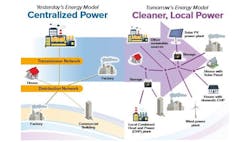New York utilities would not become obsolete, but may actually see their value increase under New York’s Reforming the Energy Vision, or REV, according to a report issued this week by Moody’s Investors Service.
REV is a regulatory remaking of electricity markets being watched carefully by other states as a possible model to manage the growing decentralized grid. The sweeping industry restructuring would give new status on the grid to local energy and likely heighten microgrid development.
This would disrupt the conventional business model of the state’s major utilities: Consolidated Edison, National Grid, Iberdrola and Fortis.
However, New York is looking at ways to reconfigure and preserve the investor-owned utility role on the disrupted electric grid. Rather than becoming obsolete, utilities may in fact “see their value increase,” Moody’s said.
“By proactively encouraging utilities to adopt a business model that supports new technologies, a long-term plan like REV could prove to be an orderly and economic response to the technology risk facing the utility industry,” said Moody’s senior vice president Mihoko Manabe in the report, “Regulated Utilities — US: NY’s REV: Seeking a Greener Utility Grid for the Environment and Investors.”
Utilities will act as the ‘distributed system platform’ for the market play of microgrids, solar and other distributed energy resources under REV. The platform would operate somewhat akin to an independent system operator (ISO), except the platform will act as an exchange for distributed energy services rather than wholesale power.
Moody’s sees New York regulators as motivated to keep utilities financially healthy under REV. The investor service noted that the state public service commission plans to implement REV gradually, giving utilities time to adjust. It also appears that REV will keep “credit-positive features” of utility rate design, such as fully forecasted test years, multi-year rate plans and decoupling.
“We believe it is credit positive that state regulators are encouraging utilities to adopt a business model that could help them stay ahead of technological changes which are certainly coming to the utilities industry,” the report says.
Moody’s cited, in particular, solar and storage and the increased technological ability for customers to control their bills. REV’s approach to harnessing those technologies may prove to be more orderly for utilities than “an alternative of scrambling to react to changes after they have already happened.”
Moody’s somewhat upbeat portrayl departs from the warnings by others that decentralized energy will create a utility death spiral. Instead, it echoes sentiments that utilities will adopt business models more befitting a decentralized grid.
“The grid still has to deliver power, even if it’s locally generated, somebody has to get it from the point of creation to the point of use. And that is still going to be a utility of some kind,” said David Chiesa, senior director for business development at S&C Electric.
New York officials have been intent on preserving a role for utilities on the new grid, and involving them in the process of creating the new rules. This is part of the reason other states are eyeing REV as a model to copy.
S&C Electric has been approached by utilities outside of New York that are evaluating REV, Chiesa said. They are trying to discern what will happen to their businesses if their home states adopt similar rules. These utilities are determined to avoid getting caught off guard as some did when states restructured the retail power business 15-20 years ago.
“They look at this and say, our regional monopoly is no longer guaranteed…we have to be prepared. How are we going to adapt and still be a succesful entity?” he said.
Source: New York State Department of Public Service
REV and Risk
Moody’s noted that REV is still being hashed out, and likely will evolve over years. Given the uncertainty about how REV will evolve, Moody’s sees it credit-neutral at best for utilities.
“REV presents uncertainty because we don’t yet have a roadmap to get to its end-vision,” says Manabe.
One business risk Moody’s pointed out involves a proposal to introduce some market-based earnings to the utilities’ overall profits. The idea is that utilities could offer some new, potentially profitable services under REV, such premium power quality or data to help competitive companies identify prospects.
“Any such adoption of competitive earnings would, by its nature, bring volatility to what have been highly stable and predictable cash flows,” the report says.
While utilities might fare fine under REV, unregulated generation companies, particular peaking operations, face negative credit implications, Moody’s said in the report.
Peaking plants might see revenues decline because REV is expected to reduce peak electric demand. Such risks are relatively unquantifiable at this point, Moody’s added, noting that peakers in congested areas downstate could remain viable to maintain reliability.
Utility REV Plans
Meanwhile, New York is taking next steps to more clearly define the utility role. The PSC staff last week recommended that utilities begin laying out details in two filings next year.
The utility plans would serve as templates to the workings of the new distributed system platform.
Specifically, they would offer a source of public information about system needs, so that distributed energy companies can identify opportunities.
The plan also would serve as the template for utilities to develop and articulate an integrated approach to planning, investment and operations. And it would demonstrate how the utilities are working with market participants.
The commission envisions multi-year utility plans, which would be filed with the commission and updated regularly. The plans would document a utility strategy over a five-year period, with a formal filing occurring every two years.
The first utility filing would be a “self-assessment” that describes immediate changes that a utility can make to reflect REV policies and goals. It would be filed by June 30, 2016.
The second filing would supplement the first with the state’s utilities working together to specify shared tools, process, and protocols to manage distribute resources. It would be due by Sept. 1, 2016.
The commission is now seeking comments on the staff recommendation. Comments are due by December 7, 2015.
Track New York’s REV by joining our LinkedIn Group, Microgrid Knowledge.







